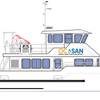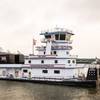Two significant efforts are under way at Washington State Ferries to shape the ferry system following passage of Initiative 695 (I-695), which eliminated $52 million from the WSF budget. One is a short-term project: Rewriting the sailing schedule for remaining years in the current budget. The second is to examine ways of raising revenue in future years to restore ferry service, including a statewide ballot measure that would approve higher ferry fares.
Given the difficult task of cutting service, the ferry system has adopted goals of maintaining core weekday service as much as possible, and trimming night, non-essential mid-day and off-season recreational trips. Under this plan, passenger-only service will be eliminated, and 10 ferries will be taken out of service.
Creating an actual sailing schedule that follows those goals is now in the hands of David Remagen, WSF schedule planning manager. Much of the input from the public about the new schedule will come through the Ferry Advisory Committees (FACs), citizen groups on each route that advise ferry system management on ferry issues.
In the San Juans, FAC Chairman Bob Distler said plans to reduce service will affect important day time runs. The complexity of the schedule in the San Juans makes it difficult to just eliminate non peak-time service, he says. "The proposed cuts will come during critical hours," said Distler.
On Vashon Island, Vashon FAC Chairman Gardner Perry said eliminating the passenger-only service between the island and Seattle is a tremendous blow, affecting hundreds of regular commuters. It has been suggested the commuters can take special buses from downtown Seattle to the Fauntleroy ferry terminal, and catch the ferry there to Vashon.
"But Metro has said it will cut its service," Perry asked. "So will there be buses available?"
At the south end of Vashon Island, cutting four hours of service a day will hurt people commuting to work, commercial truckers, and students going to activities on the mainland, said Jerry Long, chairman of the Vashon/Tahlequah FAC. Ferry riders on the route are particularly disappointed because they had lobbied state lawmakers for several years to obtain the service that will now be cut.
On Bainbridge Island, sparse evening service will be an inconvenience for island residents at baseball games, concerts and other events, said Bainbridge FAC Chairman Forrest Six. Ferries would run in the evenings every 90 minutes; the last two trips would be at 11:15 p.m. and 1:30 a.m. Also, Bainbridge Island will be hit by more traffic from evening travelers who would normally take the Edmonds/Kingston route, where service is being canceled on weeknights.
At Keystone on Whidbey Island, service cutbacks could mean fewer tourists, which will hurt the many tourist-dependent businesses on central Whidbey. "There are a lot of one- and two-person businesses and other places that depend on tourists for survival," said Julia Hodson, chairwoman of the Keystone FAC. "They'll be especially hard hit."
At Fauntleroy, the main concern is additional traffic that will come with eliminating passenger-only service between downtown Seattle and Vashon, and the dropping of plans to start new passenger-only service between Seattle and Southworth.
"We, as a community, had lobbied the state for years to start passenger-only service at Southworth," reported Gary Dawson, chairman of the Fauntleroy FAC. "Our incentive was to reduce single-occupant vehicles on city streets. No doubt this will put more vehicles on the streets."
The Tariff Policy Committee (TPC), a 25-member group that advises the state Transportation Commission on ferry fares, has worked hard over the past four months to draft a series of recommendations to raise revenues to keep ferries operating. The task was complicated by the possibility that any farebox increases might have to be approved by voters on a statewide ballot, according to the mandates of I-695. In late January, the Transportation Commission approved the TPC's recommendation to move forward with public meetings on its plan.
The plan calls for significant across-the-board increases, which will be needed for two consecutive years. The recommended range for the first-year increase (effective in January 2001, assuming the measure passed on the November 2000 ballot) averages between 40 and 50 percent. Increases in the San Juans would be an additional five percent higher.
While increases average between 40 and 50 percent, increases on some routes would actually be as low at 23 percent. This proposal stems from TPC research on fare equities taking place before I-695 passed. The committee has been looking at ways of making fares equitable and consistent throughout the ferry system for several years. Therefore, some rates wouldn't increase as much as others.
Under these proposed fare increases, enough money would be raised each year to provide enough funds to continue operations under a scaled-back schedule.
The TPC will hold a series of public hearings in March to hear public response to the proposal. The committee will then convene in April to review the information from the hearings and prepare final recommendations to the state Transportation Commission. The Commission is tentatively scheduled to hold a public hearing on the issue in June in Seattle.
Subscribe for
Maritime Reporter E-News
Maritime Reporter E-News is the maritime industry's largest circulation and most authoritative ENews Service, delivered to your Email five times per week









